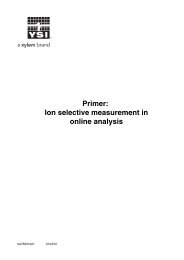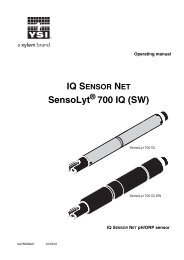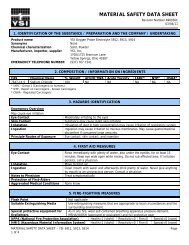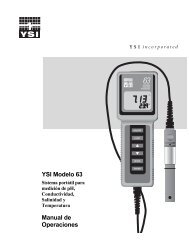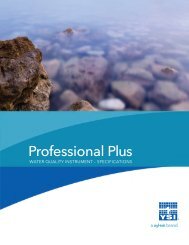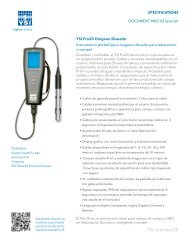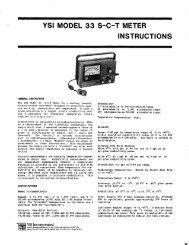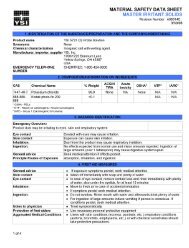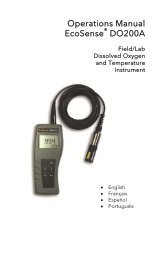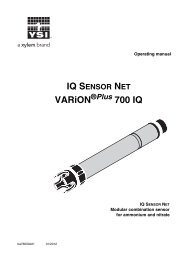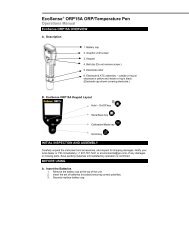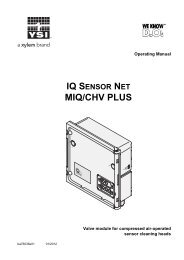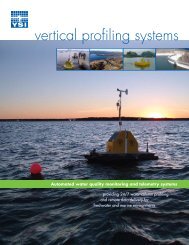Water Tracing with Rhodamine Sensor - YSI Systems
Water Tracing with Rhodamine Sensor - YSI Systems
Water Tracing with Rhodamine Sensor - YSI Systems
You also want an ePaper? Increase the reach of your titles
YUMPU automatically turns print PDFs into web optimized ePapers that Google loves.
Y S I Environmental Pure Data for a Healthy Planet. ®<br />
White Paper<br />
<strong>Water</strong> <strong>Tracing</strong>, In Situ Dye Fluorometry<br />
and the <strong>YSI</strong> 6130 <strong>Rhodamine</strong> WT <strong>Sensor</strong><br />
Introduction<br />
The growing interest in the development of accurate waste<br />
load and assimilative capacity models, as well as in models for<br />
determination of transport and fate of instantaneous pollutant<br />
discharges, has increased the need for the accurate characterization<br />
of water movement. In the United States, programs such as National<br />
Pollutant Discharge Elimination System (NPDES) and Total<br />
Maximum Daily Loads have been a significant impetus behind this<br />
interest. <strong>Water</strong> tracing using dye fluorometry is the most common<br />
method by which data are collected for these purposes.<br />
The extensive use of fluorescent dyes as water tracers began in<br />
the early to mid-1960s (Pritchard and Carpenter 1960). Prior to that<br />
time, floats, chemical salts, and actual contaminants had been used<br />
as tracers. Radioisotopes, i.e., tritium (“heavy hydrogen”), became<br />
popular after WWII but their use was limited due to handling<br />
problems, training requirements and public misunderstanding<br />
(Wilson, et. al. 1986). Dye fluorometry was first applied for<br />
measurement of time of travel (TOT) of solutes in streams and, to<br />
date, this remains its most used application. Although a number of<br />
dyes are available for fluorometric hydrologic studies, <strong>Rhodamine</strong><br />
WT is recommended because it is easy to use and has many features<br />
which are desirable for water tracing (Wilson, et. al. 1986), and<br />
because it is the most conservative of dyes available (Kilpatrick and<br />
Wilson 1988).<br />
Until the advent of in situ <strong>Rhodamine</strong> WT measurement<br />
systems, dye fluorometry hydrologic measurements were performed<br />
exclusively by the analysis of multiple samples physically extracted<br />
from the water body, at multiple locations, as the dye plume was<br />
naturally dispersed. To date, the greatest percentage of these<br />
investigations are performed using fluorometers designed for in<br />
vitro and pump-through measurements. Although these methods<br />
predominate today, and can produce accurate hydrologic data, they<br />
are resource-intensive, significantly vulnerable to human error and<br />
other natural phenomenon, and necessitate the field deployment of<br />
personnel throughout the duration of the study which increases risks<br />
to safety. The advent and recent employment of in situ measurement<br />
systems has accentuated the limitations of in vitro and pumpthrough<br />
methods for performing these studies. As the demand for<br />
the quantity and quality of hydrologic data increases, investigators<br />
have begun to search for alternatives, and have indicated that in situ,<br />
unattended measurement will be the method of choice for future<br />
dye fluorometry hydrologic measurements.<br />
Applications for <strong>Rhodamine</strong> WT dye tracing include, but are<br />
not be limited to: TOT (surface water and groundwater); reaeration<br />
studies; dispersion studies; discharge measurements (by dyedilution<br />
methods); waste buildup and flushing in estuaries and bays;<br />
wastewater retention and flushing in wetlands; combined and sanitary<br />
sewer overflows; tracing circulation and stratification in reservoirs;<br />
path tracing in karst (cavernous limestone); determination of welldrilling<br />
fluid circulation time; irrigation water uptake by plants;<br />
tagging and tracing herbicide, and tracing heated water.<br />
Fluorescence and Fluorometry Basic Theory<br />
The term fluorescence generally refers to a form of luminescence,<br />
i.e., any emission of light not directly ascribable to heat (Wilson, et.<br />
al. 1986). Upon irradiation from an external source, a fluorescent<br />
substance (i.e., <strong>Rhodamine</strong> WT) will fluoresce, that is, emit radiation<br />
(light) of lower energy (longer wavelength). In accordance <strong>with</strong><br />
Stoke’s Law, the energy emitted by electrons returning to the groundstate<br />
is of a lower energy (longer wavelength, lower frequency) than<br />
that which caused the excitation state. When irradiance ceases,<br />
fluorescence ceases.<br />
It is this property of dual spectra – a different specific combination<br />
of excitation and emission spectra for each fluorescent substance<br />
– and the near instantaneous nature of this sequence of events, that<br />
describes the principle behind fluorometric measurements, and that<br />
is used to make fluorometry an accurate and sensitive analytical tool<br />
(Undefriend 1962, Wilson et. al. 1986). Each fluorescent substance is<br />
characterized by a specific excitation spectrum and specific emission<br />
spectrum. The excitation spectrum is the variation in intensity of<br />
emitted light <strong>with</strong> the wavelength of the absorbed light. The emission<br />
spectrum is the variation in intensity of emitted light <strong>with</strong> the<br />
wavelength of the emitted light (Wilson et. al. 1986).<br />
All dye fluorometry methods, whether designed for discrete or<br />
flow-through in vitro measurement or in situ measurement, adhere<br />
to the principals described above. The characteristics or properties<br />
of the dye being considered for the application are tantamount in<br />
importance. If the spectral properties of the dye are such that a dyespecific<br />
excitation energy can be selected for transmission into the<br />
water, and dye fluorescence-specific filters can be selected to receive<br />
emission energy (fluorescence) from the dye, the fluorometer can be<br />
configured for the near-exclusive measurement of the concentration<br />
of that dye. This special configuration can greatly minimize<br />
interferences that would compromise data quality and accuracy.<br />
©2001 <strong>YSI</strong> Environmental +1 937 767 7241 Fax +1 937 767 9353 environmental@ysi.com www.ysi.com<br />
Page 1<br />
1006 E46-01
Y S I Environmental Pure Data for a Healthy Planet. ® White Paper<br />
Specifically about <strong>Rhodamine</strong> WT<br />
Of the multitude of fluorescent dyes on the market today,<br />
few exhibit the features that are essential for dye fluorometry<br />
hydrologic studies. Although a number of dyes have utility in<br />
certain applications, over the years two dyes, both variations of<br />
the same molecular structure (xanthene), have surfaced as the<br />
fluorescent dyes of choice for these studies: intracid rhodamine<br />
B and <strong>Rhodamine</strong> WT. Of these, <strong>Rhodamine</strong> WT is preferred<br />
for most dye fluorometry hydrologic studies due to its ease<br />
of use, relatively low cost, low adsorptive tendency, strong<br />
fluorescence, high diffusity, chemical stability, and benign character<br />
in the aquatic environment ( Parker 1973, Smart and Laidlaw 1977,<br />
Wilson, et. al. 1986, Kilpatrick and Wilson 1988).<br />
In addition, the spectral characteristics of <strong>Rhodamine</strong> WT<br />
are unlike those found <strong>with</strong> most other substances in ambient<br />
waters (surface water, groundwater, estuarine and marine<br />
water), making it well-suited for use as a water tracer (Wilson, et.<br />
al. 1986).<br />
<strong>Water</strong> <strong>Tracing</strong> and Dye Fluorometry for<br />
Hydrologic Studies<br />
Basic Theory<br />
Though dosing and sampling procedures and data analysis<br />
methods vary <strong>with</strong> application, in general, the standard procedure in<br />
dye fluorometry hydrologic studies is to introduce a quantity of dye<br />
into a water body, and subsequently collect water samples over some<br />
spatial and temporal regime. These samples are then analyzed <strong>with</strong><br />
a fluorometer for the concentration of the dye that is proportional<br />
to its fluorescence.<br />
Dyes mimic the movement of water molecules. A measure of<br />
the movement of a dye (i.e., <strong>Rhodamine</strong> WT) will in effect be a<br />
measure of the movement of the water and, therefore, substances<br />
transported by the water in which it is introduced. Dispersion and<br />
mixing occur in all dimensions of the water body (Wilson, et. al.<br />
1986). For example, in streams vertical mixing typically occurs first.<br />
Subsequently, and depending on current, channel configuration<br />
and stream characteristics, lateral mixing and longitudinal mixing<br />
follow. These phenomena are the subjects of interest to investigators<br />
employing dye fluorometry. For other bodies the sequence of mixing<br />
phenomena may vary, but the principle holds true nevertheless.<br />
The concentration of a dye used as a water tracer is directly<br />
proportional to its fluorescence. Therefore, a plot of dye concentration<br />
(or fluorescence) made in spatial and temporal context can reveal<br />
the TOT and dispersion characteristics of the water or of a waterborne<br />
substance under the conditions in which the study was<br />
performed. With care, theoretical models or simulations of TOT<br />
and dispersion responses, under conditions differing from those<br />
during actual studies, can be developed. These serve as useful tools<br />
for understanding aquatic system mechanics and responses to<br />
perturbation under different and varying flow conditions.<br />
Factors Affecting <strong>Rhodamine</strong> WT Fluorescence in<br />
Ambient <strong>Water</strong>s<br />
There are a number of physicochemical factors that must be<br />
considered when performing dye fluorometry hydrologic studies.<br />
A complete identification of these factors and the mechanisms<br />
by which they interfere <strong>with</strong> dye fluorescence and fluorometry is<br />
beyond the scope of this work. However, this topic is discussed in<br />
great detail in numerous publications such as those listed in the<br />
References section of this document. Suffice to say that fluorescence<br />
is affected in varying degrees by certain physicochemical factors,<br />
listed as following in relative order of importance: concentration,<br />
water (sample) temperature, interference, quenching, photochemical<br />
decay, sorption, pH and dissolved oxygen. Please note that seasonspecific<br />
and climate-specific conditions, as well as the extent of<br />
perturbation, will necessarily shift the relative importance of these<br />
factors.<br />
Concentration is paramount in importance in dye fluorometry<br />
hydrologic studies. Dye fluorescence varies directly <strong>with</strong> dye<br />
concentration. Great care must be taken to insure that an adequate<br />
volume of dye is being used to permit accurate and precise<br />
measurement of dye concentration (fluorescence) for the duration<br />
and extent of the study, and that concentration is not so high as to<br />
exceed detectable limits of the fluorometer.<br />
Second only to concentration in importance is temperature<br />
among factors affecting dye fluorescence (Wilson et al. 1986).<br />
Fluorescence activity increases, indicating an apparent higher dye<br />
concentration, as water (sample) temperature decreases. As water<br />
(sample) temperature increases, fluorescence activity decreases,<br />
indicating an apparent decrease in dye concentration. <strong>Water</strong> (sample)<br />
temperature compensation must be performed, or significant<br />
measurement errors are likely to occur.<br />
Fluorescent substances found in aquatic systems, that might share<br />
excitation or emission spectra <strong>with</strong> <strong>Rhodamine</strong> WT, and thereby be<br />
source of interference, include, but are not limited to: algae; certain<br />
salt compounds; naturally occurring colored organic compounds,<br />
and manmade organic pollutants (i.e., dyes, petroleum distillates,<br />
detergents).<br />
As stated in a previous section, each fluorescent substance<br />
©2001 <strong>YSI</strong> Environmental +1 937 767 7241 Fax +1 937 767 9353 environmental@ysi.com www.ysi.com<br />
Page 2<br />
1006 E46-01
Y S I Environmental Pure Data for a Healthy Planet. ® White Paper<br />
is characterized by a specific excitation and a specific emission<br />
spectrum. That not <strong>with</strong>standing, many fluorescent substances<br />
share some part, albeit often a small part, of the excitation and/or<br />
emission spectrum of another substance. This is a potential source<br />
of error that must be considered when performing dye fluorometry<br />
hydrologic studies.<br />
Quenching is the suppression of fluorescence, and results from<br />
the action of other substances in solution <strong>with</strong> the dye. Quenching<br />
agents may act in any or all of the following manners: (1) absorb<br />
excitation energy; (2) absorb emission (fluorescence) energy; (3)<br />
degrade excitation-state energy; and (4) chemically alter the dye<br />
molecular structure (Williams and Bridges 1964). Chlorine is an<br />
example of a quenching agent that changes fluorescent properties<br />
of <strong>Rhodamine</strong> WT by altering its molecular structure.<br />
Great care must be taken to use distilled or deionized water when<br />
preparing dye dilutions for injection to the water body to avoid<br />
the effects of chlorine. As well, it is important to account for these<br />
effects when studying chlorinated effluents and waters receiving<br />
chlorinated effluents.<br />
Photochemical decay or photodecomposition results from<br />
exposure of the dye to bright sunlight for extended periods of time<br />
and can cause permanent reduction in fluorescence (Wilson et al<br />
1986). Generally speaking, stream depth, turbidity, cloud cover,<br />
shading by riparian canopy and duration of study are all factors<br />
affecting dye exposure to sunlight, therefore, influencing the extent, if<br />
any, of photochemical decay. It is important to note that <strong>Rhodamine</strong><br />
WT is particularly susceptible to photochemical decay.<br />
<strong>Water</strong> tracing dyes have a tendency to adhere to (adsorption) or<br />
to be incorporated in (absorption) suspended matter, sediments,<br />
aquatic plants and aquatic animals which results in the physical<br />
loss or attenuation of dye as it moves through or <strong>with</strong>in the water<br />
body. Sorption (adsorption or absorption) is not a factor affecting<br />
fluorescence; rather the effects are similar to those from photochemical<br />
decay or quenching, in that there is a decreased recovery of dye. Dye<br />
losses by sorption, photochemical decay and quenching have a direct<br />
impact on the accuracy of discharge measurements, but are rarely<br />
significant enough to impact TOT, dispersion or reaeration<br />
measurements. Dye loss is a critical factor in groundwater studies<br />
(Wilson et al. 1986).<br />
As a rule, organic sediments tend to adsorb more dye than<br />
inorganic sediments. Although sorption can be a factor affecting<br />
dye fluorometric studies, fortunately <strong>Rhodamine</strong> WT is only slightly<br />
susceptible to sorption in most situations (Wilson et al. 1986).<br />
Turbidity can be a significant source of physical interference.<br />
Substances comprising water turbidity can themselves be fluorescent<br />
or not. Interference by those that exhibit fluorescence has been<br />
discussed previously. Those substances or particles suspended in<br />
the water column that are not fluorescent nevertheless reflect and<br />
refract light to varying degrees based on their quantity, shape, size,<br />
motion (if any) in and through the water, and particle density. If<br />
turbidity is high enough and/or enough of these compounding<br />
factors are involved, transmitted as well as emitted light will be<br />
inhibited. Therefore, interference from turbidity must be rejected at<br />
the point of measurement, or fluorescence data must be corrected<br />
for the effects of turbidity.<br />
The pH of a sample may also affect fluorescence intensity, therefore<br />
the measured concentration of dye. Fluorescence of <strong>Rhodamine</strong> WT<br />
is stable in the pH range of 5-10 and decreases outside those limits<br />
(Feuerstein and Sellek 1963). Decreased fluorescence due to pH<br />
variation is generally not a problem except in studies of instantaneous<br />
pollutant discharges; industrial waste streams; acidic streams, and<br />
certain stages of municipal and industrial waste treatment.<br />
In highly aerated waters, such in the whitewater reaches of<br />
mountain streams or in other situations where super-saturation<br />
of dissolved oxygen exists, oxygen can manifest the same effect<br />
as chlorine (Wilson et al. 1986). Care should be taken to identify<br />
stream reaches where there is potential for this problem and to<br />
quantify its effects.<br />
Applications<br />
Dye fluorometry hydrologic studies are conducted to provide data<br />
for waste load and assimilative capacity models, as well as to estimate<br />
the passage (transport, mixing, diffusion) of noxious substances<br />
instantaneously discharged to a water system or water body. The<br />
representative accuracy of a water quality model is typically no<br />
better than the hydrologic data on which it is based (Wilson et. al.<br />
1986). Assimilative capacity, estimates of retention, and transport of<br />
suspended sediments and nutrients, as well as many other aspects<br />
of an aquatic system that are addressed in water quality models, are<br />
all highly dependent on accurate hydrologic data.<br />
For purposes of this discussion, applications for dye fluorometry<br />
can be placed into three general categories: surface water, wastewater<br />
and groundwater. Surface <strong>Water</strong> includes freshwater, brackish<br />
water, seawater, and non-point source pollution (not including<br />
municipal stormwater). Wastewater includes municipal and<br />
industrial wastewater; combined sewers; industrial pretreatment,<br />
and municipal stormwater. The Groundwater category represents all<br />
groundwater studies including, but not limited to, natural systems,<br />
wastewater injection, landfill monitoring and remediation.<br />
©2001 <strong>YSI</strong> Environmental +1 937 767 7241 Fax +1 937 767 9353 environmental@ysi.com www.ysi.com<br />
Page 3<br />
1006 E46-01
Y S I Environmental Pure Data for a Healthy Planet. ® White Paper<br />
Surface <strong>Water</strong><br />
The impetus behind surface water applications of dye fluorometry<br />
is largely the need to develop the water quality and waste load models<br />
used to describe surface water system response to perturbation, and<br />
to help <strong>with</strong> the establishment of criteria necessary for restoration<br />
and/or protection of surface water systems. Time of travel (TOT)<br />
studies are an integral component of this work and are performed<br />
exclusively using dye fluorometry. In the US, programs such<br />
as NPDES and TMDL continue to increase the need for dye<br />
fluorometric hydrologic measurements.<br />
Though their data will have different applications, dispersion,<br />
mixing, reaeration and circulation studies all seek to determine the<br />
distribution characteristics of a physical and/or chemical feature,<br />
phenomenon or substance — be it natural or anthropogenic,<br />
<strong>with</strong>in, and often out of, an aquatic system. Dispersion and mixing<br />
studies are typically aimed at understanding more about the likely<br />
distribution of pollutants, for example a spill, by-pass, or heated<br />
effluent discharge. Mixing studies, though similar and often<br />
considered integral to distribution studies, are often designed more<br />
to estimate and demonstrate the downstream distance where mixing<br />
– as defined by various criteria – occurs.<br />
Reaeration studies are performed in a wide variety of surface water<br />
systems, such as hydroelectric reservoirs, lakes, streams, bays and<br />
estuaries. Reaeration studies using dye fluorometry are designed to<br />
determine the dispersion and mixing of a gas or gases, usually of<br />
oxygen, <strong>with</strong>in and out of the system. For example, dye fluorometry<br />
reaeration studies are used to evaluate the efficacy of practices such<br />
as air injection employed to mitigate suppressed DO levels. These<br />
studies may be performed using the actual gas under consideration<br />
(i.e., oxygen) or may use a tracer gas such as butane to mimic the<br />
dispersion, mixing and dissipation characteristics of the actual gas<br />
under consideration.<br />
Surface <strong>Water</strong> Applications<br />
• Time of travel (TOT) studies<br />
• Dispersion: i.e., discharged contaminants, turbidity from dredging<br />
and runoff<br />
• Mixing zone identification, characterization<br />
• Reaeration studies: i.e., reservoirs, lakes, streams, bays<br />
• Circulation patterns: i.e., lakes, reservoirs, bays and estuaries<br />
• Discharge measurements (by dye-dilution methods)<br />
• Bay and estuary hydraulics<br />
• Wastewater and stormwater retention in wetlands<br />
• Irrigation water uptake by plants<br />
• Tagging and tracing herbicide migration and dispersion<br />
• Spill mapping and response<br />
Wastewater<br />
Flow analysis and characterization in municipal and industrial<br />
wastewater facilities is part of the operational SOP. The effectiveness<br />
and efficiency of a treatment facility depends largely on adherence to<br />
hydraulic design. Phenomenon such as “short-circuiting” profoundly<br />
affects a facility’s performance. Short-circuiting can be detected<br />
relatively quickly and corrective measures assessed through the use<br />
of dye fluorometry. This work is driven by operational requirements,<br />
as well as effluent quality regulations, therefore it is not typically as<br />
government program-dependent as are many hydrologic studies<br />
such as TOT.<br />
Monitoring stormwater hydraulics, retention times in stormwater<br />
catchments, and stormwater quality are critical components of<br />
municipal and industrial pollution abatement programs. Dye<br />
fluorometry is a valuable tool for making the measurements<br />
necessary to model these pollution sources, as well as to test the<br />
effectiveness of treatment methods.<br />
Unfortunately, sewage collection system overflows are a common<br />
occurrence, and are often due to undersized or dilapidated collection<br />
systems. One factor contributing to these overflows is infiltrationinflow<br />
to the system by surface water and groundwater. This is<br />
particularly acute during storm events and flooding where water<br />
enters the collection system from the surface (manholes and open<br />
covers) and through cracks in the pipes. Often dye fluorometry is<br />
used to assess hydraulic capacity of collection systems, as well as<br />
identify quantities and sources of infiltration-inflow.<br />
In many cities throughout the world stormwater and sewage are<br />
combined. Hydraulic capacities of these systems are often exceeded<br />
during storm events, and discharges from them often occur. Dye<br />
fluorometry is used to assess hydraulic capacity of these systems, to<br />
identify quantities and sources of infiltration-inflow to the system,<br />
and to determine the dispersion of discharges (overflows) from them<br />
to groundwater and surface water.<br />
Wastewater Applications<br />
• Hydraulic characterization of WWTF (Wastewater Treatment<br />
Facilities) for operational, environmental purposes<br />
• WWTF aeration and reaeration basin mixing studies<br />
• WWTF contact chamber residence time analysis, operational,<br />
environmental purposes<br />
• WWTF influent plume tracing, operational purposes<br />
• Wastewater collection system discharge measurements (by dyedilution<br />
methods)<br />
• Combined and sanitary sewer overflows<br />
• Stormwater hydraulics, pond retention time<br />
©2001 <strong>YSI</strong> Environmental +1 937 767 7241 Fax +1 937 767 9353 environmental@ysi.com www.ysi.com<br />
Page 4<br />
1006 E46-01
Y S I Environmental Pure Data for a Healthy Planet. ® White Paper<br />
Groundwater<br />
Although it is common knowledge <strong>with</strong>in the scientific community<br />
that contamination of groundwater will lead to the same in surface<br />
water, and vice versa, the ignorance or disregard of this fact has<br />
facilitated many practices in resource exploitation and waste disposal<br />
that have resulted in the contamination of groundwater and surface<br />
water systems around the world. It is for this reason primarily that the<br />
communication between surface water and groundwater systems<br />
have been under investigation for many years.<br />
The determination of TOT, direction, path and dispersion of<br />
groundwater is particularly difficult. With the exception of some<br />
karst regions, where groundwater movement may be more similar to<br />
surface water streams, most groundwater movement is remarkably<br />
slow and characterized by complex dispersion patterns. Varying<br />
geologic strata, wells, pumping, mining and surface features that<br />
facilitate or inhibit recharge, all affect groundwater current, direction<br />
and dispersion, thereby greatly complicating the study of pollutants<br />
<strong>with</strong>in groundwater systems.<br />
One of the most effective means by which groundwater and the<br />
movement of groundwater contaminants can be studied is through<br />
the use of dye fluorometry. Although fluorescein has been more<br />
commonly used in groundwater tracing applications, <strong>Rhodamine</strong> WT<br />
is widely used and in some cases may be preferable since fluorescein<br />
is a common constituent in both sewage and landfill leachate (Duley<br />
et al. 1999). Sorption to soil and bedrock, and quenching by chemical<br />
degradation of dye by groundwater contaminants are the principal<br />
sources of error in dye fluorometry groundwater tracing. These<br />
“losses” are exacerbated by the typically long TOT and complex<br />
dispersion patterns of groundwater. For these reasons, in situ dye<br />
fluorometry in groundwater has less utility than in surface water<br />
and wastewater applications. There are exceptions, however, such<br />
as in landfill leachate and surface pit disposal studies where TOT<br />
is relatively short, dispersion patterns are less complex, and where<br />
down-hole measurements of dye concentrations are needed along<br />
<strong>with</strong> the other important groundwater tracing parameters such as,<br />
specific conductance and temperature (Duley et al. 1999).<br />
Groundwater Applications<br />
• Time of Travel<br />
• Surface to groundwater communication: presence and paths<br />
• Pollution plume tracing: landfills and spill sites<br />
• Aquifer hydraulics<br />
• Bore hole casing integrity<br />
• Determination of well-drilling fluid circulation time<br />
• Tagging and tracing herbicide migration and dispersion<br />
In Situ Dye Fluorometry Requirements and<br />
the 6130 <strong>Rhodamine</strong> WT <strong>Sensor</strong><br />
Until the advent of in situ <strong>Rhodamine</strong> WT measurement systems,<br />
dye fluorometry hydrologic studies were performed exclusively by<br />
the analysis of multiple samples physically extracted from the water<br />
body, at multiple locations, as the dye plume was naturally dispersed.<br />
These samples were analyzed either in the field or in the laboratory.<br />
To date, the greatest percentage of the analysis (fluorometry)<br />
performed for these investigations has employed field fluorometers<br />
designed for discrete and pump-through in vitro measurement. The<br />
mode of operation during one of these investigations is often referred<br />
to as “leap-frogging” and alludes to the process whereby teams – at<br />
least two – collect samples, perform analysis and then move to a<br />
predetermined point or distance downstream of the preceding team.<br />
This process is continued downstream until the stream reach under<br />
investigation has been sampled and the dye plume has passed.<br />
Over the years, automated sampling systems such as time-actuated<br />
dye-sampling boats, and time and flow-actuated peristaltic pump<br />
samplers have greatly reduced personnel requirements and labor<br />
costs associated <strong>with</strong> sample collection. However, samples collected<br />
by these devices must be retrieved <strong>with</strong>in a short time after a<br />
sampling event and still require in vitro analysis either in the field<br />
or in the laboratory.<br />
Although the aforementioned methods often produce accurate<br />
hydrologic data, they are resource intensive: deployment of personnel,<br />
vehicles and equipment is necessary throughout the duration of the<br />
study, sampling supplies are used in quantity, and discrete or flowthrough<br />
in vitro analysis is performed manually throughout the<br />
duration of the study. Furthermore, these methods are significantly<br />
vulnerable to human error and other natural phenomenon, and their<br />
large personnel component increases risk of injury. The limitations of<br />
these methods have become accentuated <strong>with</strong> the advent and recent<br />
employment of in situ <strong>Rhodamine</strong> WT fluorometers. As the demand<br />
for the quantity and quality of hydrologic data increases, investigators<br />
have begun to search for alternatives, and have indicated that in situ,<br />
unattended measurement will be the method of choice for future<br />
dye fluorometry hydrologic measurements.<br />
Fluorometers, whether designed for discrete or pump-through in<br />
vitro analysis or in situ measurement, operate according to the same<br />
principles identified in an earlier section of this document. Given<br />
this commonality, the utility of the method and the technology by<br />
which it is employed must necessarily come into question as the next<br />
step in selecting the appropriate fluorometer.<br />
In response to the need for in situ dye fluorometry for hydrologic<br />
©2001 <strong>YSI</strong> Environmental +1 937 767 7241 Fax +1 937 767 9353 environmental@ysi.com www.ysi.com<br />
Page 5<br />
1006 E46-01
Y S I Environmental Pure Data for a Healthy Planet. ® White Paper<br />
studies, such widely recognized companies including, but not limited<br />
to, Turner Designs (SCUFA III TM ), Hobi Labs (Hydro-Scat-2 TM ),<br />
Chelsea Instruments (Aqua Tracka TM ), and <strong>YSI</strong>, Inc. (Model 6130<br />
sensor) have developed in situ fluorometers for the measurement of<br />
<strong>Rhodamine</strong> WT. During the course of research for this document,<br />
it became apparent that the system configuration most needed by<br />
investigators is that which provides accurate – which includes the<br />
measurement of and correction for temperature and conductivity<br />
– in situ <strong>Rhodamine</strong> WT measurement for short (< 24 hr.) and long<br />
deployments (several days), and that can operate autonomously<br />
under self-contained power, while storing data internally for<br />
field or remote downloads. Generally speaking, this was true for<br />
surface water, groundwater and wastewater investigations, but<br />
not necessarily for all applications <strong>with</strong>in those areas of study. In<br />
addition, it was determined that, at times, it will be necessary to<br />
integrate the fluorometer, via SDI-12, <strong>with</strong> data collection platforms<br />
(DCPs); deploy the system in situ in 2-inch OD bore-holes; to<br />
manually perform surface and vertical profile measurements of<br />
<strong>Rhodamine</strong> WT, and to record these data along <strong>with</strong> data for other<br />
parameters.<br />
The need for parameters in addition to <strong>Rhodamine</strong> WT appears<br />
to be limited (prioritized) first to those absolutely essential for its<br />
accurate measurement (temperature and conductivity), and then<br />
including those of particular importance, but that are less commonly<br />
encountered at problematic levels during most investigations<br />
(turbidity and pH). It is important to consider that season-specific and<br />
climate-specific conditions, hydraulic features and the extent<br />
of perturbation will necessarily shift the relative importance of<br />
some of these parameters. A smaller, but significant, portion of<br />
investigators — particularly water resource agencies, environmental<br />
regulatory agencies, and persons managing wastewater treatment<br />
facility performance — need water quality parameters such as DO,<br />
pH, chlorophyll, turbidity, ORP and depth or level in addition to<br />
<strong>Rhodamine</strong> (and temperature and conductivity).<br />
At this time, <strong>YSI</strong>, Inc. offers the only <strong>Rhodamine</strong> WT fluorometer<br />
that can be configured to meet all of the requirements identified<br />
previously. At the heart of <strong>YSI</strong>’s system for <strong>Rhodamine</strong> measurement<br />
is the Model 6130 sensor. The 6130 is a fouling-resistant, wiped<br />
sensor (Figure 1) designed to seamlessly integrate – using no external<br />
interface hardware – <strong>with</strong> each of <strong>YSI</strong>’s multiparameter sondes that<br />
provide an optical port (6820, 6920, 6600 and 600 OMS) and <strong>with</strong><br />
most sensor configurations (combinations) currently available. Note<br />
that the OMS is a small (1.65-inch OD), inexpensive sonde which is<br />
ideal for groundwater applications, and for surface and wastewater<br />
applications where cost is a consideration and only <strong>Rhodamine</strong><br />
WT, temperature, conductivity, and depth or level are required.<br />
The 6130 minimizes interference from turbidity, other fluorescent<br />
substances such as phytoplankton and, by virtue of its integration<br />
<strong>with</strong> other sensors in <strong>YSI</strong> multiparameter sondes, its measurements<br />
are automatically corrected for the effects of temperature and<br />
conductivity.<br />
The need to manually perform surface and vertical profile<br />
measurements of <strong>Rhodamine</strong> WT, and to record these data along<br />
<strong>with</strong> data for other parameters, has been identified. <strong>YSI</strong> provides a<br />
rugged, weatherproof handheld device, the 650 MDS, for viewing<br />
data in real-time, and for field viewing and downloading data<br />
stored <strong>with</strong>in the sondes. With the 650 MDS the investigator can<br />
“look” into the data record <strong>with</strong>out interrupting measurements or<br />
deployment instructions, and thus determine if the dye plume has<br />
reached or passed the deployment site, while also determining if dye<br />
concentrations are <strong>with</strong>in appropriate ranges before leaving the field.<br />
The 650 MDS in combination <strong>with</strong> any <strong>YSI</strong> sonde <strong>with</strong> an optical<br />
port also facilitates surface and vertical profile measurements that are<br />
particularly useful in lakes, reservoirs, bays and deep rivers during<br />
reaeration, dispersion, circulation and mixing studies.<br />
Conclusion<br />
To date, the greatest percentage of these investigations are<br />
performed using fluorometers designed for in vitro and pumpthrough<br />
measurements. Although these methods predominate<br />
today, and can produce accurate hydrologic data, they are resourceintensive,<br />
significantly vulnerable to human error and other natural<br />
phenomenon, and necessitate the field deployment of personnel<br />
throughout the duration of the study, which increases risks to safety.<br />
The advent and recent employment of in situ measurement systems<br />
has accentuated the limitations of discrete and in vitro pump-through<br />
measurement methods for performing these studies. As the demand<br />
for the quantity and quality of hydrologic data increases, investigators<br />
have begun to search for alternatives, and have indicated that in situ,<br />
and particularly unattended in situ <strong>Rhodamine</strong> WT measurement,<br />
will be the method of choice for future dye fluorometry hydrologic<br />
measurements.<br />
Fluorometers, whether designed for discrete or pump-through in<br />
vitro analysis or in situ measurement, operate according to the same<br />
principles. Given this commonality, the utility of the method and<br />
the technology by which it is employed must necessarily come into<br />
question as the next step in selecting the appropriate fluorometer.<br />
The growing need for accurate in situ measurement of <strong>Rhodamine</strong><br />
WT during short ( < 24 hr) and long deployments (several days),<br />
and <strong>with</strong> a system that can operate autonomously under self-<br />
©2001 <strong>YSI</strong> Environmental +1 937 767 7241 Fax +1 937 767 9353 environmental@ysi.com www.ysi.com<br />
Page 6<br />
1006 E46-01
Y S I Environmental Pure Data for a Healthy Planet. ® White Paper<br />
contained power while storing data internally for field or remote<br />
downloads, was identified. Generally speaking, this need held true<br />
for surface water, groundwater and wastewater investigations, but<br />
not necessarily for all applications <strong>with</strong>in those areas of study. In<br />
addition, it was determined that, at times, it will be necessary to<br />
integrate the fluorometer, via SDI-12, <strong>with</strong> data collection platforms<br />
(DCPs); to deploy the system in situ in 2-inch OD bore-holes; to<br />
manually perform surface and vertical profile measurements of<br />
<strong>Rhodamine</strong> WT; and to record these data along <strong>with</strong> data for other<br />
parameters.<br />
<strong>YSI</strong>, Inc. was found to be the only provider of a <strong>Rhodamine</strong> WT<br />
fluorometer that can be configured to meet all of the requirements<br />
identified during this investigation. At the heart of <strong>YSI</strong>’s system<br />
for <strong>Rhodamine</strong> WT measurement is the Model 6130 sensor. The<br />
6130 is a fouling-resistant, wiped sensor designed to seamlessly<br />
integrate <strong>with</strong> <strong>YSI</strong>’s multiparameter sondes and sensor configurations<br />
(combinations), including the 1.65-inch OD Optical Monitoring<br />
System (OMS). The 6130 minimizes interference from turbidity<br />
and other fluorescent substances (i.e., chlorophyll) and, by virtue of<br />
its integration <strong>with</strong> other sensors in <strong>YSI</strong> sondes, its measurements<br />
are automatically corrected for the effects of temperature and<br />
conductivity, and may be analyzed in a broad environmental context<br />
including, but not limited to, measurements of DO, pH, ORP,<br />
chlorophyll, turbidity, depth and level.<br />
References<br />
Baker, S.H. and Holley, E.R., 1987, “Preliminary investigation of<br />
tracer gas reaeration method for shallow bays”: Texas A&M<br />
University, Texas <strong>Water</strong> Resources Institute, Technical Report<br />
No. 141, 4p.<br />
Barton, G.J., Risser, D.W., Galeone, D.G., Conger, R.W., 1999,<br />
“Case study for delineating a contributing area to a water-supply<br />
well in a fractured crystalline-bedrock aquifer”, Stewartstown,<br />
Pennsylvania: Pennsylvania Department of Environmental<br />
Protection, Bureau of <strong>Water</strong> Supply Management, <strong>Water</strong>-<br />
Resources Investigations Report 99-4047, 44p.<br />
Brown, R.T., “Aeration technology performance evaluation as an<br />
element of TMDL implementation”, 2001, San Joaquin River<br />
Dissolved Oxygen Total Maximum Daily Load Stakeholder<br />
Process, Proposal, 6p.<br />
Coffelt, G., Newman, J.M., Aziz, T, Campbell, D, Gu, B., Jorge, J.,<br />
Lopez, J., Pietro, K., and Wenkert, L., 2001, “Advanced Treatment”:<br />
South Florida <strong>Water</strong> Management District, 2001 Everglades<br />
Consolidated Report, Chapter 8, 46p.<br />
Duerr, R.K., 1999, “Bayou boeuf TMDL for dissolved oxygen<br />
including point source wasteload allocations and watershed<br />
nonpoint source load allocations subsegment 060208”: Louisiana<br />
Department of Environmental Protection, Volume 1, 40p.<br />
Duley, W, Pierce, L., and Boswell, C, 1998, “<strong>Water</strong> tracking as an aid<br />
in characterization of leachate movement from landfills”: Missouri<br />
Department of Environmental Quality, SWMP, 7p.<br />
Feuerstein, D.L., and Sellek, R.E., 1963, “Fluorescent tracers for<br />
dispersion measurements”: American Society of Civil Engineers<br />
Proceedings, v. 89, no. SA4, Paper 3586, p. 1-21.<br />
Kilpatrick, F.A. and Wilson, J.F., Jr., 1989, “Measurement of time<br />
of travel in streams by dye tracing”: U.S. Geological Survey<br />
Techniques of <strong>Water</strong> Resources Investigations, Book 3, Chapter<br />
A9, 27p.<br />
Moffa and Associates, 2000, “Generic verification protocol for<br />
induction mixers used for high rate disinfection of wet weather<br />
flows”: NSF International, Draft, 35p.<br />
Parker, G.G., 1973, “Tests of rhodamine WT dye for toxicity to<br />
oysters and fish”: U.S. Geological Survey Journal Research, v.1,<br />
no. 4, p. 499.<br />
Pritchard, D.W. and Carpenter, J.H., 1960, “Measurement of<br />
turbulent diffusion in estuarine and inshore waters”: International<br />
Association of Scientific Hydrology Bulletin 20, p. 37-50.<br />
Rathbun, J., 1995, “Field sampling plan stream and dam reaeration<br />
studies”: Rouge River National Weather Demonstration Project,<br />
RPO-MOD-FSP05.00, 47p.<br />
Smart, P.L., and Laidlaw, I.M.S., 1977, “An evaluation of some<br />
fluorescent dyes for water tracing”: <strong>Water</strong> Resources Research, v.<br />
13, no. 1, p. 15 – 33.<br />
Sterns and Wheeler, 2001, “Wet weather operating practices for<br />
POTWs <strong>with</strong> combined sewers”: New York State Department of<br />
Environmental Conservation, Technology Transfer Document,<br />
60p.<br />
Undefriend, Sidney, 1962, “Fluorescence assay in biology and<br />
medicine”: New York, Academic Press, 517 p.<br />
Wang, J.D., Daddio, E., Horwitz, M.D., 1978, “Canal discharges<br />
into Biscayne Bay”: University of Miami, Rosenstiel School of<br />
Marine and Atmospheric Science, Report to the Department<br />
of Environmental Resources Management Metropolitan Dade<br />
County, 57p.<br />
Williams, R.T., and Bridges, J.W., 1964, “Fluorescence of solutions –<br />
A review”: Journal Clinical Pathology, v. 17. P.371-394.<br />
Wilson, J.F., Jr, Cobb, E.D., and Kilpatrick, F.A., 1986, “Fluorometric<br />
procedures for dye tracing”: U.S. Geological Survey Techniques<br />
of <strong>Water</strong> Resources Investigations, Book 3, Chapter A12, p.34.<br />
©2001 <strong>YSI</strong> Environmental +1 937 767 7241 Fax +1 937 767 9353 environmental@ysi.com www.ysi.com<br />
Page 7<br />
1006 E46-01



